Andy Warhol (1928 – 1987), known by the nickname of “the Pope of Pop”, did not have an easy life, both socially and in the world of Art. Warhol was an artist who explored various areas within the artistic spectrum. He began with commercial illustration, later moving on to painting, while at the same time creating new techniques. He also made films, managed a band called The Velvet Underground and founded a cultural meeting place in New York City (the famous Silver Factory). Despite his genius, Warhol is often portrayed as a shallow artist, who has positioned himself in the art world for money and fame.
In this essay, we try to combat the argument of easy life, evidencing the depth of the artist, his art and social message. For this purpose, two of his well-known paintings will be analyzed: Campbell’s Soup Cans and Marilyn Diptych. In order to support the analysis, we use the historical and artistic context in which the artist lived and painted, and the opinions of other authors, against the background of Warhol’s own life. This way, we seek to see beyond the obvious, trying to give meaning to his expression: “I am a deeply superficial person.”
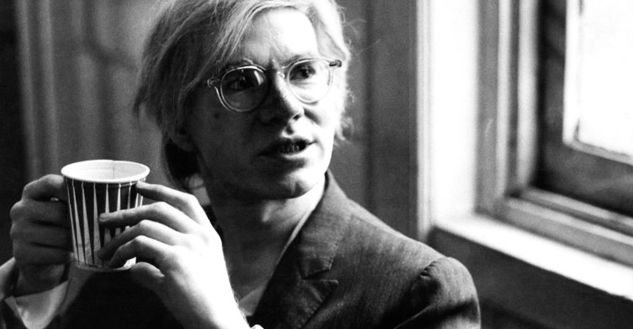
Leia este texto em português aqui.
Warhol’s Life
Born in 1928 in Pittsburgh as Andrej Varhola Jr., Warhol was the son of Ondrej and Julia Varhola, Rusyn immigrants – a group that settled in the area of present-day Slovakia. Warhol’s parents lived in a ghetto during the Great Depression of the 1930s. At the time, Pittsburgh was a steel industry city, where his father was a miner.
At the age of eight and after suffering from scarlet fever, Warhol developed Sydenham’s chorea, a neurological disorder that affects motor coordination and would greatly condition his life, since it left him with a pale appearance, fine hair and light skin. As a result, Warhol became very shy, a trait that he would carry throughout his life. Indeed, Warhol seems to have never overcome the changes in his appearance, a little queer at the eyes of others, which made him a target of social bullying and marginalization. As a result, he developed an obsession with celebrity beauty icons, most notably the actress Marilyn Monroe.
Still, as a consequence of the disease and the physical aftermath of his appearance, Warhol was forced to stop attending school, where he was bullied. Thus, for a long period of his life he was restricted to the kitchen and to his mother’s company. Therefore, it is not surprising that his mother became his greatest influence, both in his life and career. To entertain him, his mother would give to Andy magazines with movie stars, asking him to draw them and make collages. In her company, Warhol regularly attended the Byzantine Orthodox Church of St. John Chrysostom, where he admired the screens with Byzantine icons.
His father died when Warhol was only thirteen. Luckily, he left enough money for Warhol to attend the Carnegie Institute of Technology in Pittsburgh, where he studied pictorial art.
In 1949, at the age of twenty-one, Andy Warhol moved to New York City, taking with him only two hundred dollars in his pocket. It was a very difficult period in his life, he even exchanged drawings for food at the Serendipity restaurant, where he made his first exhibition. Warhol’s first job was at Glamour Magazine, prophetically titled Success in New York. He became a successful commercial illustrator in New York City, mainly due to his invention – the blurred line technique – that gave a print-like image to his illustrations. This was how Warhol started working in the world of glamour, in which he would come to be successful as an artist, consequently becoming famous.
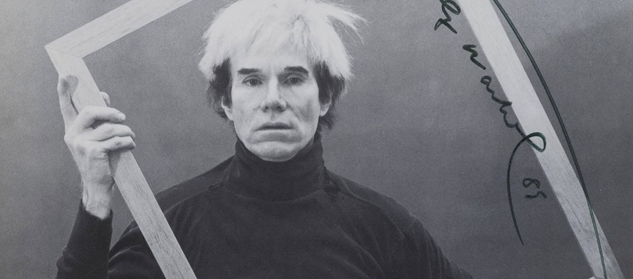
Historical and Artistic Context
Addressing Warhol’s life outside of the historical context of art significantly reduces his contribution to the history of art. On the other hand, to look at his art without discussing his life is failing to know him and limiting his interpretation. Born in a small town of Slavic immigrants, Warhol embraced 20th-century North America. While the great artists set out to change the world, Andy Warhol liked America as it was: “America really is beautiful,” he wrote. Notwithstanding this, Warhol changed the world because he changed the way we see it (Vowell, 1993).
Pop is all that art has not been for the past two decades. We basically return to representational visual communication, moving at an exceptional speed… Pop is a re-enlistment in the world… It is the American dream, optimistic, generous and naive, as defined by producer Jim Dunn. The biggest names in this movement were: Andy Warhol, Roy Lichtenstein, James Rosenquist and Claes Oldenburg.
These artists merged the concepts of art and popular culture, making the theme of their works objects of mass culture and celebrities. They were the first to not recognize a limit to culture, arguing that art could and should come from any source. This was only possible because most pop artists began their careers in commercial art. Warhol was a paradigmatic example. He began by being a successful advertising illustrator and graphic designer, which gave him the background he needed to understand the vocabulary of mass culture.
Even if each pop artist has their own approach, there is a common thread. As most of these artists want to be emotionally removed. There is, however, no consensus as to whether this is an acceptance of the popular world as it is, or whether, on the contrary, it is an alienation from the same popular world. It seems to us that they showed disappointment through their works of art and this was achieved through the traces of trauma they encountered in the media, in advertising, in cartoons and in several other popular images.
Throughout his career, Warhol identified the mass media, with its power of political influence, devoid of any attempt to inform but to manipulate – which he likened to George Orwell’s Big Brother. In an interview in 1971, when asked about its tendency to “program” the emotional response of the public, as the aftermath of the assassination of John F. Kennedy, which he criticized in POPism (1980). Warhol replied to Swenson with a quotation that can be repeated up to today’s reality: “Everyone looks and acts in a similar way, and we are increasingly like this…”, referring to the manipulating power of the mass media” (Powers, 2012).
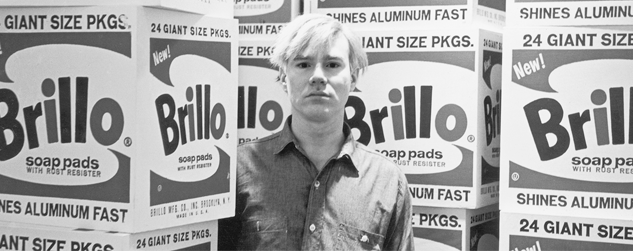
Interpreting his paintings
We think his paintings express most of the things he observed and had no other way of expressing. Warhol was shy, a man of few words and somehow socially marginalized, so everyone wrongly assumed that he had nothing to say. However, they were wrong and what Warhol tries to tell us is something deeply shocking, that we are all equal and empty.
In his interview with Gretchen Berg in 1966, Warhol says the following about himself: “If you want to know everything about Andy Warhol, just look at the surface… and there I am. There’s nothing behind it” (Powers, 2012). Certainly, there is something to be said about how this surface reflects us the knowledge about ourselves. In other words, the denial of depth, uttered by Warhol, can also be interpreted as a catharsis of desire (Leung, 2003).
To further explore this concept of superficiality, Warhol attempts to convey meaning through worldly iconography and the use of repetition, which makes us reflect. According to Dyer (2004), the images of Warhol continue and rework a tradition of Christian iconography. In his serigraphs, the frontality, the simplicity of the design and the situation of the subject in the empty space recall the popular Christian iconography of the Renaissance. This is clearly an influence he acquired in his church going days, observing the Byzantine icons. This gives Warhol’s images the ex nihilo effect of the icon’s sacred face: they look timeless and out of this world (Dyer, 2004).
This is how we want celebrities to be seen, there is a clear association between celebrity and the worship of God. Warhol’s art has adopted the content of commerce through the appropriation of goods and celebrities, but at the same time has dismantled the institutional forms through which these objectified products circulate (Joselit, 2002).
The Campbell’s Soup Cans
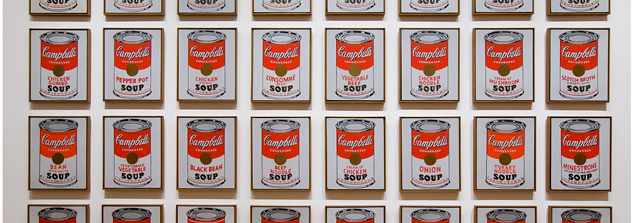
The Campbell’s Soup Cans are a collection of the thirty-two different flavors of Campbell’s Soup Cans available. Warhol was looking for inspiration and chose it as a subject because it used to be his lunch. At first, it seems like anyone could paint them. Consequently, people were not surprised and did not see value in the paintings, nor appreciated them. On the other hand, that’s why the collection was kept together.
The problem is that they only saw the surface of the painting, they did not see how the placement of each painting gave the feeling of being exposed to a supermarket of cans, stocked, one on top of the other, side by side. People also did not understand how Warhol tries to make the viewer reflect by seeing a regular image repeated successive times. How does this repetition change our mood? The viewer does not receive an obvious message, as it should be the trained viewer who sees the depth behind these paintings. Above all, it is for the viewer to problematize all the concepts of present day reality, such as sameness, normality, mediocrity and consumerism.
Warhol’s images are products of “a semiconscious mind that duplicates without the awareness of the original identity.” (Bergin, 1967) Warhol attempts this through the use of two devices or approaches: on the one hand, the most important in terms of “doctrine”, being an approach and reproduction already mentioned of the subject. On the other hand, this lack of awareness, this emphasis on mere reproduction of the image without any understanding of its original identity, is the act of a machine (Bergin, 1967).
Marilyn Diptych
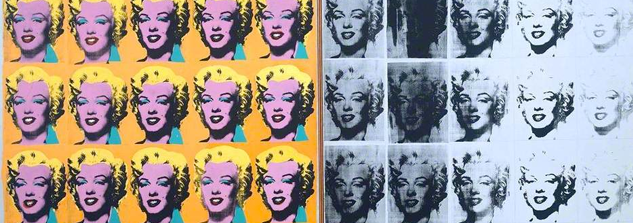
There are over twenty versions of this painting, repeatedly showing Marylin Monroe. The only change is in the background with orange shifting slowly to black. Marilyn Diptych was painted using the technique of screen printing, which consists of printing with paint on it. This technique detracted from any translation or evidence of the artist’s hand in favor of a mass-produced, machine-like appearance. Then, Warhol used a photograph of Monroe’s Niagara movie advertisement (1953) and the silk screen for the face. The photo under the paint was no more than a mask. This technique reduces the person / face to something behind a mask, which is the celebrity status.
In this painting, we can clearly see the influence of Byzantine art, the movie stars and the magazines together. They have become icons of worship, but this worship is seen as negative despite being glamorous – as Warhol portrays celebrity as a product to be consumed. Thus, we realize that he was one of the artists that best captured the spirit of fame and celebrity. That is, immortalizing the concept of fame while recognizing its brevity at the same time. Warhol said: “In the future, everyone will have fifteen minutes of fame.” At this point, he clearly states the dismay that celebrities go through. This is the main focus of this painting.
Warhol simplifies everything as detail is replaced by strong, colorful cartoons. By altering the tonality of each image, Coplans suggests that Warhol develops the temporal effects of Monet’s Impressionist paintings (Dyer, 2004). We think that Warhol goes even further than that. Through his use of enlightenment, he shows us decadence, dehumanization, consumption, and even death. In this particular case of a celebrity like Marilyn Monroe, a beloved icon who was found dead. Thus, in this painting, he gradually portrays the various stages of Monroe’s life, in phases until culminating in her death. In fact, it was only after this tragic event that Marilyn Diptych was painted.
The Legacy of Pop Art
Ultimately, Andy Warhol represents the American dream: he has climbed various social strata, from the son of poor immigrants to being successful in the United States of America. Warhol conquered New York City and lived the night and artistic version of the American dream (Vowell, 1993).
In addition, he left his mark on the art world. It is also understandable that he constantly sees himself as the stranger and wants to be different, for this he creates a kind of alter ego that is indifferent and cold. By cultivating his alter ego, Warhol was able not only to administer and control personal information about him but, paradoxically, to create for himself a zone of privacy in the public domain. In effect, by denying “the other person the satisfaction of discovering [his difference] to themselves” (Powers, 2012).
Warhol said that “the idea is not to live forever, but to create something that will last forever”. Certainly, his art is still worthy of contemporary interpretation and we felt that he influenced new artists, such as Alec Monopoly. Andy Warhol’s message: see the depth below the surface, that art is for everyone, and that it may be about popular culture. In this sense, he is considered the best representative of Pop Art of his generation.
After this essay, it became much clearer to us that Warhol intended to portray mass production and consumerism. Simultaneously, he saw people, especially celebrities, as products to be consumed by the general public. In a way, he became a prophet of the mechanisms of celebrity and mass media. Hence, we think that comes from his famous quote “In the future, everyone will have 15 minutes of fame”.
In fact, if we all look at his paintings on a superficial level, we will not find much, at most, we may see Marilyn and a can of soup. As it turns out, Warhol seems to produce art of repeated symbols to the point of superficiality, yet there is depth. That is, clearly something more than this happens. In addition, if we see this as a whole and not just a piece, there are other reflections to be made: his paintings make us think of expiration dates, deadlines, death, worship, fame, consumerism, immediate gratification, wide supply of goods, loss of identity and dehumanization.
In short, life in an instant, or how celebrities are consumed by us, like supermarket products. Or, moreover, we reflect on the quantity of products we have available and on how to deal with this availability. This is mainly because we think his art is still so alive in our day, perhaps more than ever.
Through his paintings, we can see ourselves radiographically and the reality we live in: a world that is interested in celebrities and wear fast consumerism, where celebrities are quickly replaced by others. This evidence is present more than ever. We are becoming increasingly superficial, as our main goal is to follow the trends, which in a way are dictated by celebrities. The depressing reality of our daily concerns include: watching reality shows, soap operas, series, among other entertainment sources. This leads to a uniformity that is unhealthy and can be seen in Warhol’s paintings because he had already seen the beginning of this process of standardization in society.
Want to know more about Andy Warhol’s work? Check out the trailer for the exhibition of his works in 2012 at the ArtScience Museum in Singapore.https://www.youtube.com/embed/okdjbW590sE
Note: I would like to thank Professor Reinaldo Silva (University of Aveiro) for his contribution and guidance during the writing of this essay.
References
Bergin, Paul. “Andy Warhol: The Artist as Machine.” Art Journal, vol. 26, no. 4, 1967, pp. 359–363., www.jstor.org/stable/775065.
Dyer, Jennifer. “The Metaphysics of the Mundane: Understanding Andy Warhol’s Serial Imagery.” Artibus Et Historiae, vol. 25, no. 49, 2004, pp. 33–47., www.jstor.org/stable/1483746.
Joselit, David. “Yippie Pop: Abbie Hoffman, Andy Warhol, and Sixties Media Politics.” Grey Room, no. 8, 2002, pp. 63–79., www.jstor.org/stable/1262608.
Leung, Simon. “… And There I Am: Andy Warhol and the Ethics of Identification.” Art Journal, vol. 62, no. 1, 2003, pp. 4–5., www.jstor.org/stable/3558464.
Mattick, Paul. “The Andy Warhol of Philosophy and the Philosophy of Andy Warhol.” Critical Inquiry, vol. 24, no. 4, 1998, pp. 965–987., www.jstor.org/stable/1344114.
Powers, Edward D. “‘All Things That I Didn’t Want to Change Anyway’: Andy Warhol and the Sociology of Difference.” American Art, vol. 26, no. 1, 2012, pp. 48–73., www.jstor.org/stable/10.1086/665629.
Scherman, Tony, and David Dalton. “Pop: the genius of Andy Warhol.” New York, Harper, 2010.
Vowell, Sarah. “Reading a Poker Face: Books on Andy Warhol.” Archives of American Art Journal, vol. 33, no. 4, 1993, pp. 25–31., www.jstor.org/stable/1557529.



